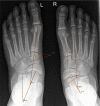Tarsometatarsal bone remodelling after subtalar arthroereisis
- PMID: 32582390
- PMCID: PMC7302416
- DOI: 10.1302/1863-2548.14.190190
Tarsometatarsal bone remodelling after subtalar arthroereisis
Abstract
Purpose: Subtalar arthroereisis has been described for the treatment of flexible juvenile flatfoot. However, the mechanism responsible for deformity correction has not yet been investigated adequately. The aim of this study was to document the effect of subtalar arthroereisis on the tarsometatarsal bone morphology.
Methods: We retrospectively reviewed the clinical and radiological data of 26 patients (45 feet) with juvenile flexible flatfoot deformity treated by subtalar arthroereisis at our department between 2000 and 2018. Radiological evaluation included angular measurements of tarsometatarsal bone morphology as well as hindfoot and midfoot alignment. Mean radiographic follow-up was 19.4 months (sd 8.8; 12 to 41).
Results: A significant change of angular measurements of tarsometatarsal bone morphology was found after subtalar arthroereisis (p < 0.001). While there was an increase of the distal medial cuneiform angle (DMCA) and the medial cuneo-first metatarsal angle on the anteroposterior view, a decrease of the naviculo-medial cuneiform angle and the medial cuneo-first metatarsal angle was seen on the lateral view. Furthermore, we found significant improvements of all hindfoot and midfoot alignment parameters except the lateral tibio-calcaneal angle and the calcaneal pitch angle (p < 0.001).
Conclusion: Our data support the theory of tarsometatarsal bone remodelling, which may contribute to the effect of subtalar arthroereisis for the treatment of flexible juvenile flatfoot.
Level of evidence: IV.
Keywords: bone remodelling; flatfoot; radiological outcome; subtalar arthroereisis.
Copyright © 2020, The author(s).
Figures



Similar articles
-
Mid-term Results of Subtalar Arthroereisis with Talar-Fit Implant in Pediatric Flexible Flatfoot and Identifying the Effects of Adjunctive Procedures and Risk Factors for Sinus Tarsi Pain.Orthop Surg. 2021 Feb;13(1):175-184. doi: 10.1111/os.12864. Epub 2020 Dec 17. Orthop Surg. 2021. PMID: 33332772 Free PMC article.
-
Therapeutic Outcomes of Kalix II in Treating Juvenile Flexible Flatfoot.Orthop Surg. 2017 Feb;9(1):20-27. doi: 10.1111/os.12309. Orthop Surg. 2017. PMID: 28371501 Free PMC article.
-
Calcaneal Z Lengthening Osteotomy Combined With Subtalar Arthroereisis for Severe Adolescent Flexible Flatfoot Reconstruction.Foot Ankle Int. 2016 Nov;37(11):1225-1231. doi: 10.1177/1071100716658975. Epub 2016 Jul 9. Foot Ankle Int. 2016. PMID: 27402620
-
Subtalar arthroereisis combined with medial soft tissue reconstruction in treating pediatric flexible flatfoot with accessory navicular.J Orthop Surg Res. 2023 Jan 19;18(1):55. doi: 10.1186/s13018-023-03542-w. J Orthop Surg Res. 2023. PMID: 36658597 Free PMC article. Review.
-
The outcomes of subtalar arthroereisis in pes planus: a systemic review and meta-analysis.Arch Orthop Trauma Surg. 2021 May;141(5):761-773. doi: 10.1007/s00402-020-03458-8. Epub 2020 May 6. Arch Orthop Trauma Surg. 2021. PMID: 32377845
References
-
- Pfeiffer M, Kotz R, Ledl T, Hauser G, Sluga M. Prevalence of flat foot in preschool-aged children. Pediatrics 2006;118:634-639. - PubMed
-
- Harris EJ. The natural history and pathophysiology of flexible flatfoot. Clin Podiatr Med Surg 2010;27:1-23. - PubMed
-
- Bouchard M, Mosca VS. Flatfoot deformity in children and adolescents: surgical indications and management. J Am Acad Orthop Surg 2014;22:623-632. - PubMed
-
- Evans AM, Rome K. A Cochrane review of the evidence for non-surgical interventions for flexible pediatric flat feet. Eur J Phys Rehabil Med 2011;47:69-89. - PubMed
Publication types
LinkOut - more resources
Full Text Sources
Research Materials

